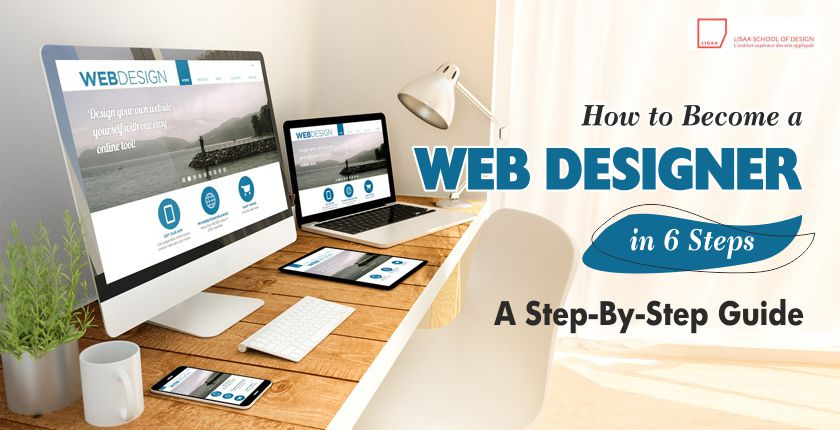Blog
How to Become A Web Designer In 6 Steps: A Step-By-Step Guide
- March 27, 2023
- Posted by: lisaadelhi
- Category: Graphic & Web Design Blog

Have you been dreaming of career as web designer for a while now? Web designer future scope is really high with smart income. If so, this step-by-step guide is here to show you how! Learn how to start your web design career in as little as 6 steps – from choosing the right software to finding clients and launching your own website.
Introduction to Web Design
As the internet continues to grow and evolve, so does the demand for web designers. If you have a passion for design and a desire to build beautiful websites, then a career in web design may be for you!
Becoming a web designer is not as difficult as you may think. With the right training and some hard work, you can be designing beautiful websites in no time!
Here is a step-by-step guide on how to become a web designer:
1. Choose your niche.
The first step to becoming a web designer is to choose your niche. Do you want to design corporate websites? Or maybe you’re more interested in designing e-commerce sites? Once you’ve decided on your niche, you can start researching the best ways to serve that market.
2. Get educated.
Once you know what kind of websites you want to design, it’s time to get educated. You don’t need a formal degree in web design, but taking some courses or getting certified will give you the skills and knowledge you need to be successful. There are many great online resources that can help you learn everything from basic HTML to CSS and beyond.
3. Build a portfolio.
After you’ve got the education part down, it’s time to start building your portfolio. Start by creating some simple designs and then move on to more complex projects as you gain experience.
Step 1: Learn the Basics of HTML and CSS
Web design is a process of creating a website that looks and works the way you want it to. The first step in becoming a web designer is to learn the basics of HTML and CSS. These are the two most important languages for creating websites.
HTML is used to create the structure of a web page. It is made up of a series of elements, which are enclosed in tags. For example, the tag <p> represents a paragraph element.
CSS is used to style the content of a web page. It makes use of selectors to target specific elements on a page, and then apply styles to them. For example, you could use CSS to make all paragraphs on a page have blue text.
There are many resources available online for learning HTML and CSS. Lissa Delhi is a good place to start. Once you have learnt the basics, you can begin creating your own web pages!
Step 2: Gain Familiarity with Web Design Tools
Now that you know what skills are required to be a web designer, it’s time to start familiarizing yourself with the tools of the trade. While there is a wide variety of web design software available, we recommend starting with the basics. Adobe Photoshop, Illustrator, and Dreamweaver are industry-standard design programs that will give you a strong foundation on which to build your web design career.
If you’re not sure where to start, there are plenty of resources available online to help you get started with these programs. Once you’ve got a handle on the basics, you can start experimenting with more advanced design techniques and software. As your skillset grows, so will your options for landing great web design jobs.
Step 3: Develop Your Graphic Design Skills
If you want to become a web designer, you will need to develop your graphic design skills. This can be done by taking classes, reading books or blogs on the subject, or practicing on your own.
If you take classes, make sure to find a reputable school or online course. Look for courses that cover the basics of graphic design, such as color theory, typography, and composition. These concepts are essential for any designer, no matter what type of design they eventually specialize in.
In addition to taking classes, another great way to learn graphic design is to read books and blogs on the subject. There are many great resources out there that can teach you about the basics of graphic design and help you hone your skills. A few good ones to start with are The Design of Everyday Things by Don Norman and Graphic Design Basics byAmy Elam.
Finally, don’t forget that practice makes perfect. The more you work on honing your graphic design skills, the better you will become at it. So get out there and start designing!
Step 4: Explore Responsive Design Concepts
As a web designer, you should be familiar with responsive design concepts. Responsive design is a method of designing and coding a website so that it can adapt to the different screen sizes and resolutions of different devices. This means that your website will look great on all devices, from desktop computers to mobile phones.
There are a few key things to keep in mind when creating a responsive website:
- Use fluid layouts: This means that your website’s layout should change depending on the screen size. For example, on a small screen, you might want to stack your content vertically, while on a larger screen you might want to have your content laid out horizontally.
- Use media queries: Media queries are CSS code that allows you to target specific styles for specific devices. For example, you might use a media query to only show certain styles on mobile devices.
- Use responsive images: Images can be made responsive by using the srcset attribute. This allows you to specify different image files for different device resolutions.
- Use icon fonts: Icon fonts are vector icons that can be scaled up or down without losing quality. They’re perfect for use on responsive websites.
Step 5: Learn How to Manage a Web Development Project
As a web developer, it is your responsibility to manage web development projects from start to finish. This includes managing the project budget, scope, timeline, and risks.
Project management is a critical skill for any web developer. It allows you to successfully deliver projects on time and within budget. Furthermore, effective project management also helps to minimize risks.
There are a number of different project management methodologies that you can use, such as Agile or Waterfall. However, whichever methodology you choose, there are some key steps that you need to take in order to successfully manage a web development project.
1. Define the project scope. The first step is to define the project scope. This includes understanding what the project objectives are and what needs to be delivered in order for the project to be considered successful. It is important that the scope is realistic and achievable; otherwise the project is likely to fail.
2. Create a project plan. Once the scope has been defined, you need to create a detailed project plan. This should include all of the tasks that need to be completed, who is responsible for each task, and when each task needs to be completed by. The project plan will help keep everyone on track and ensure that the project stays on schedule.
3. Manage risks. All projects come with some level of risk. It is important that you identify any potential risks early on and put plans in place to mitigate them.
Step 6: Get Certified In Web Design
If you want to be a web designer, you need to get certified in web design. There are many online courses and bootcamps that can help you get started, but the best way to learn is by getting an internship or apprenticeship with a web design company.
This will allow you to get real-world experience and learn the ropes from experienced professionals. Once you have some experience under your belt, you can then take the next step and get certified in web design.
Why Choose Us?
Becoming a web designer can be an exciting and rewarding career path. Lissa Delhi offers an online web designing course with the right tools, you can learn the skills needed to create stunning websites for businesses and individuals alike. By following the six steps outlined in this guide, you can start your journey on becoming a successful web designer.
From learning HTML and CSS coding languages to using content management systems like Word press or creating graphics with programs such as Adobe Photoshop, there are endless possibilities available once you’ve begun your journey into web design. So why don’t you get started today?
Leave a Reply Cancel reply
You must be logged in to post a comment.

